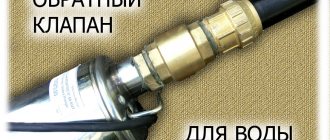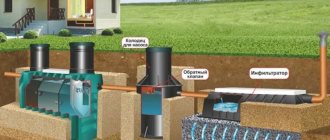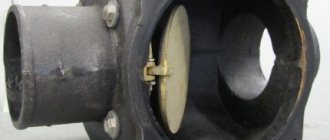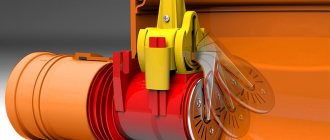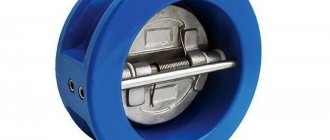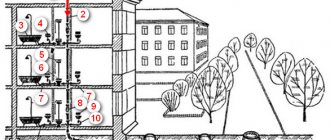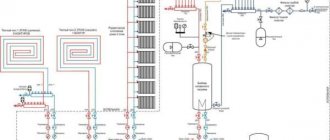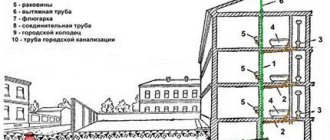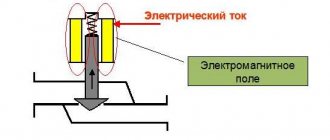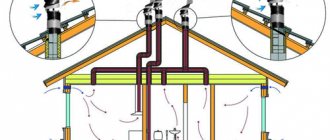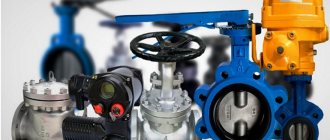When designing and installing sewer systems, great attention is paid to ensuring the safety of their use - removing unpleasant odors, explosive gases, and preventing sewage from entering the home. One of the effective means for protecting premises from the penetration of fecal waste is a 50 mm sewer check valve.
It is worth noting that sewer check valves are not mandatory elements in the system. But in some specific cases they can be useful, preventing the slightest possibility of dirty water appearing in the home.
Rice. 1 Check valve for sewerage 50 mm - appearance
Purpose of the locking device
The check valve is an important element of the “protective fittings” of any pipeline. Its main purpose in the overall technological system is to prevent a possible change in the direction of the flow of the working fluid. All valves of this type freely pass the working medium in the desired direction and prevent its movement in the opposite direction.
The purpose of check valves in sewer systems is similar - by releasing waste from the internal sewer system into the general house system, they prevent their reverse flow in the event of a plug, blockage or other problem on the subsequent section of the pipeline.
Additional functions of the products are to protect individual housing construction from wastewater that overflows the drain well; prevent rodents from accessing the sewer system (for this, a 50 mm sewer check valve is often used).
Dry valve for sewerage
In terms of design, a dry sewer valve is fundamentally different from a hydraulic one. It is made in the form of a polypropylene tube with threads at the ends.
The internal structure of dry valves contains a special membrane that acts as a check valve. Therefore, unlike a hydraulic valve, such a valve performs a regulatory function - it prevents water from moving in the opposite direction through the system.
The dry shutter is more functional; it works both independently and in combination with a water device. It requires monitoring less often, but it is not allowed to be installed in kitchen sinks where dishes are washed - in such an environment the valve will last very little.
Types of dry seals:
- Membrane. The most common option is in which liquid enters the sewer as a result of a membrane opening under the pressure of water.
- Float This is a combination of dry and water valve types. It consists of a drain with a vertical outlet equipped with a ball-shaped float valve.
- Pendulum dry. It has only one attachment point and deviates from the axis under the pressure of the liquid, opening the passage. Returns to its original position under the influence of gravity.
- Valves with molecular memory. They are considered high-tech devices, the elements of which, thanks to molecular memory, always return to their original position and seal the structure.
When selecting a valve, it is necessary to take into account the number of drains passing through the device. For a washbasin, the diameter of the shutter passage can be 50 mm, and for a shower cabin - 100 mm. If there is no large free space, a horizontal shutter option is better.
Design and principle of operation of the product
Check valve in operation
Standard check valve components:
- Housing with pipes (inlet, outlet) and inspection cover.
- A working shut-off element - disk, valve, membrane, ball - to shut off the pipeline over the entire internal cross-sectional area.
- Seal to ensure a tight fit of the working element to the body during reverse flow of drainage masses.
- Return spring of the locking element.
- Lever mechanism for forced opening of the valve manually. It makes it easy to adjust the position of the damper. It can be fixed vertically or horizontally.
The check valve works as follows. Initially, the damper blocks the entrance to the housing chamber. The pressure of the flow of drainage masses lifts it without obstacles, and the water or the contents of the toilet rushes to the sewer without delay. If there is a blockage or blockage in the pipes located behind the valve, a reverse flow of liquid occurs. Its pressure presses the working element against the support ring of the housing and reliably closes the passage - liquid waste does not return to the apartment or house.
Purpose and scope of application
Such devices are usually installed in the bathrooms of the first and second floors of multi-storey buildings on taps for connecting plumbing fixtures. It stops the backflow of fecal water into the room in case of blockages in the sewer pipes.
Most often, traffic jams form in the basement in pipes located horizontally. Then all the drains begin to rise to the first accessible exit point - the toilet in the first floor apartment. The valve prevents the unpleasant consequences of blockage by blocking the lumen of the sewer pipe and the connection point of the device. However, wastewater can rise even higher through the riser - to the plumbing fixtures on the second floor. Therefore, the sewage system of second-floor apartments must also be equipped with check valves. The drainage column usually does not rise above this level - it will already be able to push through the plug and the water will drain away.
In cottages connected to a centralized main, the valve is installed before discharge to the sewer well from the inside of the foundation structure.
Such a device is also necessary for autonomous drainage systems of private houses and cottages with drainage into a drainage pit or with an installed septic tank. A check valve is also used to drain condensate from an air conditioner, excess water from water heaters, drain ventilation of baths, saunas, etc.
Classification of products used
Based on the type of working locking element, the following design options for sewer pipe valves are distinguished:
- Lifting . The principle of their operation is described above. The passage through them is blocked by a damper or disk.
- Rotary (petal) . A distinctive feature is that the locking membrane resembles a petal. They work similarly with lifting type products.
- Ball . The locking element is a balloon filled with air. With the “correct” movement of waste liquids, it rises and rolls into the recess provided for by the design of the housing. The flow passes freely into the common drain system, and the ball then rolls back to its original place under its own weight. In an emergency, the reverse flow, with its pressure, presses the sphere harder, which reliably blocks the passage.
- Wafer . These check valves are suitable for sewer pipes with a pipe size of 50 mm. Products in the shape of a low cylinder with a rotary valve are placed inside the pipe. They are capable of passing only water without any solid particles or inclusions - therefore they are designed for discharging liquid from sinks and bathtubs.
check valve types
Types of valves and principle of operation
There are several types of sewer check valves of 110 and 50 millimeters, which differ in their scope of application. Accordingly, all types of mechanisms have a different design and operating principle of one element.
In general, all varieties have a single mechanism of operation of the system: in a quiet state, the blocking valve is located at the bottom, thus closing the lumen of the pipeline and preventing the reverse flow of liquid.
When the waste liquid approaches, the damper automatically rises, after which it returns to its original position. It is by the mechanism of operation of the damper that models of sewer check valves are classified.
Rotary
This type of sewer valve has a spring-loaded membrane (it is called a plate because of its round shape). When the wastewater moves in the right direction, the plate rotates and moves upward without impeding the movement of liquids.
However, when the drains are directed in the opposite direction, the spring-loaded membrane is pressed tightly against the outer rim, as a result of which the working area of the pipeline is blocked.
Some models additionally have a built-in additional damper, which is controlled manually. This locking mechanism can be adjusted using a special button located on the body of the device.
Due to the peculiarities of the design shape, this type of check valve for sewerage 50/110 mm is also called petal. As a rule, the device body is larger in size than the dimensions of the pipe where it is mounted.
Thus, the pipeline first has an expanding and then a narrowing section, which is a possible place for the formation of a blockage in the sewer system. The solution to this problem is to place the lid mechanism at the top of the housing. By removing it, you can easily and quickly remove the clog that appears.
Lift valve for sewerage
The name of this type of device is based on the mechanism of the damper.
When wastewater moves in the correct direction, the flapper is positioned at the top. Operating principle: the liquid exerts pressure on the membrane, which blocks the movement of waste, the internal spring is compressed, as a result of which the damper rises. If the wastewater does not move, then the spring is in its normal state, and the path of the wastewater is blocked.
Due to the nonlinear body shape, when the fluid moves in the opposite direction, opening the valve is impossible, which ensures complete safety from flooding.
This type of check valve for sewage 110 or 50 mm has greater operational reliability than the rotary (petal) model, but there is also a drawback.
The shape features make it necessary to regularly clean the system, because... it gets clogged periodically. To perform this procedure, you will need to unscrew the bolts (4 pcs.), then thoroughly clean or, if such a need arises, replace the working mechanism. If the owner has the opportunity to carry out regular cleaning, then it is better to purchase a similar version of the check valve.
Ball valve
In this type of device, the locking element is a small ball. The upper part of the body is designed in such a way that when wastewater flows, the ball falls into a separate hole and allows the flow to move.
When there is no fluid present, the working area of the pipe is blocked, preventing flow from flowing in the wrong direction. However, such models have a drawback - unlike the rotating and lifting mechanism, in this design the ball valve does not completely adhere to the rim of the device.
As a result of a leak, a small amount of waste water may leak. Of course, the likelihood of severe flooding, as if the sewer check valve were missing entirely, is minimal.
Wafer
The main advantage of this type of locking mechanism is its small dimensions, which makes installation possible even if there is no free space behind the plumbing fixtures. Externally, the device looks like a miniature cylinder with a special rotary valve.
This element can consist of 2 components that are fixed to the central rod, or in appearance it can resemble a small plate that is fixed to the body using a spring mechanism.
It is advisable to install this option only if other varieties cannot be installed. Even taking into account the small size, it is still advisable to give preference to other types of devices. A 50 mm wafer check valve for sewerage is installed quite rarely, because... belongs to the category of water supply equipment. For sewer systems, its efficiency is quite low.
Another disadvantage of this design is the inability to quickly clean the device. Due to its shape, the connection will need to be completely disassembled to clean the valve.
The valve installation method allows us to distinguish the following designs:
- Flanged . Suitable for connection to large cross-section pipes that have a similar fastening element. The valve with flanges is conveniently mounted on pipeline sections with a vertical or horizontal arrangement.
- Bell- shaped The valve with a conical socket and a rubber sealing ring easily mates with other pipeline elements.
- Couplings . The products are designed to mate with pipes (mostly metal) of small diameters - up to 2.5 inches.
Flanged and Union Check Valve
The material for the manufacture of check valves is:
- Stainless steel . Used for the production of interflange products. Other types of valves can also be manufactured for inclusion in a metal pipe system. In products made from other materials, stainless steel dampers can be used.
- Polyvinyl chloride (PVC) . The most common material for large cross-section sewer valve bodies.
- Polypropylene . The sewer check valve 110-315 mm polypropylene remains operational at +95°C without deformation. The housing material includes components that can partially suppress the operating noise of the product.
- ABS plastic . This thermoplastic resin produces durable and impact-resistant housings for check valves.
- Cast iron . Such designs are recommended for installation in loaded systems (usually external) made of large-section cast iron pipes.
Product materials and sizes
The dimensions (mounting diameter) of a check valve for sewerage in an apartment depend on the cross-section of the pipeline for which it is intended:
- for toilets choose check valves DN110 mm,
- for main pipelines of internal systems DN50 mm,
- for external sewerage systems - DN150-DN200 mm and more if necessary.
32 mm and 40 mm products are also used.
For the manufacture of sewer check valves, the same materials are used as for the production of pipes:
- plastic,
- steel,
- cast iron.
Plastic models are often installed in internal systems made from appropriate pipes with a small diameter.
Cast iron pipes and, accordingly, cast iron check valves are recommended for powerful (mainly external) pipelines with a large cross-sectional area that experience heavy loads.
Valve Selection Tips
- To install the valve, before connecting the apartment sewer system to the common house sewer system, select a product for a non-pressure system.
- Any type of valve can be installed in front of the bathtub or sink. The main requirement for it is compliance with the fastening and diameter of suitable pipes.
- When installing the valve in a vertical riser, use a product with the appropriate mark on the packaging.
- Valve models designed only for vertical installation should not be used on horizontal sections of the pipeline, and vice versa.
- You cannot install a valve designed for pressure in a non-pressure system - it works with crushed waste materials and will quickly become clogged with waste from the toilet.
- To install a plastic valve on a pipeline made of cast iron or steel, special plastic adapters will be required.
- Models of products with flanges must be placed on pipes with the same type of fastening.
- It is not advisable to install metal valves on plastic pipes.
- The cost of check valves can vary by an order of magnitude. However, expensive models do not guarantee great advantages during operation.
Before purchasing
Before purchasing a check valve for the sewer system, you need to decide on the exact location of its installation and know the type of sewer system - free-flow or pressure (with a pump in the pipe system).
When choosing the required model, they also take into account the dimensions of the product, the manufacturer’s warranty period, build quality, complexity of the upcoming installation, material, functionality, and recommendations of practitioners.
Why do you need a non-return valve for a sewer?
Purpose
The sewer systems that the average consumer encounters can be roughly divided into individual and communal apartment buildings.
In private homes without access to a centralized sewer line, wastewater is discharged into septic tanks and then into drainage wells or filtration fields. In this case, the entire pipeline can be divided into two sections - a vertical riser inside the house and a horizontal section outside underground.
In communal apartments, the consumer deals only with a vertical riser running through all floors. Next, the riser pipeline passes into a horizontal section, through which wastewater is sent to the centralized sewer system.
The causes of blockage in any sewer system are violations of the rules for using the system by consumers who dump foreign objects and materials into it. They can be personal hygiene products, rags, bulky food waste.
Rice. 2 Operating principle of a check valve
When the passage channel is clogged, the wastewater is not drained, accumulates in the pipeline and rises up. Mainly through toilets and less often through bathtubs, showers, and sinks, they penetrate into rooms, causing unpleasant odors and sometimes flooding sanitary facilities.
It is to prevent such phenomena that a valve for a 110 mm sewer and a check valve for a 50 pipe are designed.
The larger 110th will prevent the penetration of wastewater through the toilets, and the smaller 50th will serve as a barrier for them when other plumbing fixtures are located at the lowest connection point - bathtubs, sinks, showers.
In the vast majority of cases, check valves are installed in individual houses, but some designs can be used in any type of housing.
Another function of check valves is to prevent small rodents from entering the premises. Naturally, this problem is relevant for the private sector in houses where an autonomous sewage system is installed. Mice and rats have the opportunity to enter the house through open pipes leading to septic tanks and drainage wells.
Related article:
How to eliminate the smell in the sewer in a private house - affordable methods. In this article, we analyze the possible causes of odor, system installation errors, as well as how to eliminate odor in accessible and inexpensive ways.
Rice. 3 Design of a typical valve
The nuances of installing sewer valves
- Before installation, you must perform a visual inspection of the purchased product. For further work, leave the structure without visible defects, chips, cracks and deformations.
- After this, the functionality of the valve in the bath is checked using water, which is alternately supplied from different sides through the body pipes. If necessary, at this stage it is easy to eliminate minor faults or replace the product under warranty.
- There is always an arrow on the body of any model. It helps to correctly orient the product during installation - with an arrow towards the common collector or drain well.
- Before work, you must definitely agree with the residents of your riser (from apartments on the upper floors) about a temporary refusal to use water supply and sewerage. Such forethought helps to avoid unexpected troubles.
- If the materials of the product and pipes are different or have different diameters, you will need to install special transition elements that are purchased in advance.
- Each connecting joint must be sealed.
- After installing the valve, the functionality of the drain system and the tightness of the connections are checked. Deficiencies are immediately eliminated. If there are no problems, the sewerage system is suitable for use.
For self-installation
Every home craftsman can independently install a valve of any type. You don’t need a professional or any expensive tool for this. The non-return valve for sewerage is not yet a well-known and widespread device. Therefore, for those who first encountered the product and decided to install it, the following tips will be useful.
Installation of a check valve is simplified if it is sequentially assembled together with all elements of the future sewer system into a common chain. This happens when the entire drainage system of an apartment or house is completely replaced during a major renovation or during the construction of a new home.
When installing the device in an operating sewer system, the role of preliminary marking and careful removal of the pipe section for inserting the valve in this place is important. Installation on metal and cast iron pipes is more complicated than on plastic ones - it may require the involvement of specialists with practical experience in performing such work.
You may also like - Slope of sewer pipes according to SNiP
Connection type
The product can be connected in two ways:
- For a common sewer pipe - a valve with a diameter of 110 mm or more, with greater throughput;
- for the outlet of each plumbing fixture. Internal wiring is usually made from pipes with a diameter of 50 mm. The valves should have the same dimensions. If the system circuit is assembled from pipes with a diameter of 32 mm or 40 mm, special adapters are used when connecting a device with DN = 50 mm.
The devices are installed at the junction of pipes, turning 90º both inside and outside buildings.
According to the method of connection to the process, they are divided into:
- threaded;
- coupling;
- flanged;
- for welding.
Valve Maintenance
Timely inspection and periodic maintenance of the check valve increases the service life of the device and ensures its reliable operation.
Important! At the stage of designing the drain system and installing the valve, it is necessary to provide for ease of access to the product for the necessary maintenance.
The sewer valve is serviced quarterly. To do this, remove or unscrew the top inspection cover. Then a visual inspection of the condition of the product is carried out, the debris accumulated in it is removed, and, if necessary, the edging and/or damper is replaced. The reason for unscheduled maintenance of the check valve may be the deterioration of the drain system, the presence of additional unnatural noise and vibrations in the valve when draining waste.
When servicing the valve in use, you should also follow the manufacturer's recommendations specified in the product instructions.
Installation features
An air valve is placed in the drain pipe; it is necessary to prevent the appearance of an unpleasant and harmful sewer smell in the apartment. At the moment of abundant discharge of wastewater, a vacuum occurs in the riser, to compensate for which air is sucked in from a plumbing fixture that has the smallest water seal and is located nearby. Water is noisily forced out of the water seal, clearing the passage into the room for sewer gases. A vacuum vent valve is a device that introduces air into the system and does not release it back. It is also called a breathing valve.
The operating principle of the aerator is as follows:
- When the pressure in the riser is equal to or slightly above atmospheric pressure, the fan valve is closed;
- When the water flow in the toilet is flushed or the washing machine is drained, a strong pressure surge occurs in the system;
- The membrane clears the passage into the side opening of the aerator;
- Through this hole, atmospheric air is introduced into the system until the pressure outside and inside the pipe is equal;
- The ventilation valve returns to the closed position.
Before installation, it is recommended to watch a training video.
It is possible to install one aerator at the top of the sewer riser and install valves on each plumbing fixture. At the same time, it is necessary to ensure easy access to the aerator for inspection and repair.
Causes and consequences of sewer blockages
Possible destruction or mechanical damage to pipeline elements creates an emergency situation. But most often, emergency situations in sanitary systems for the removal of products from human household activities are associated with the occurrence of internal blockages, which necessarily provoke a stop and reverse movement of the discharged wastewater.
A simple malfunction leads to serious problems, which usually affect the lower floor apartments of apartment buildings or the sanitary premises of the lower level of private buildings. The location of the blockage in these cases is in the horizontal sewer pipes passing through the basement. Residents of the upper floors can also suffer, which happens less frequently. To do this, it is enough to have a plug in the vertical riser between floors. Installing a sewer check valve eliminates the possibility of such domestic accidents in apartments. This device will also protect private homeowners.
Causes of plugs and blockages in drain pipes:
- Blockage of the drain pipe due to violation of the rules for using the sewer system. In this case, the traffic jam is created by large food waste, diapers, plastic bags, cotton wool, pieces of thick cardboard, rags and other bulky items that are not sent to a special garbage container.
- Long-term operation of pipes is accompanied by the gradual formation of sediment on their inner walls and a decrease in the working clearance (section). Subsequently, the rough inner surface of the pipes more easily retains solid particles, which settle and gradually form an impenetrable plug in the overall system.
- Incorrect pipeline slope allows solid particles to settle on its walls. To avoid this, the flow of discharged liquids must have a certain speed. To change the slope of the pipes, you will have to completely redo the problematic system.
- The formation of plugs is also facilitated by bends located perpendicular to the main pipeline. The flow of liquid in these areas slows down sharply, delaying large inclusions - the reason for the formation of plugs.
The consequence of an internal blockage of a sewer pipe that occurs for any of the reasons listed is the accumulation of liquid and its reverse flow. Immediately, the toilet bowl (closest to the plug site) accumulates with the contents of the waste system, with possible overflow of the liquid mass over the edge. In this situation, the unpleasant smell ceases to be a problem, in comparison with the upcoming cleaning, repairs and expenses for purchasing new things to replace the damaged ones.
Device
The valve design consists of a hexagonal body, the cavity of which is divided into several zones:
- the receiving part located before the shut-off organ. This area is intended to connect the inlet to the wastewater pipeline;
- limiter. Provides unhindered passage of drain water in only one direction and locks the valve in case of reverse movement;
- a locking device fixation system with an additional function of an inspection hatch;
- graduation part. It is designed to ensure the exit of liquid from the restrictor area and the connection of the device to the outlet line.
The design of all working zones comes in different design options, but the operating principle is the same for all models of check valves.
Connection diagram
Schemes for installing check valves are developed in accordance with the technical characteristics of the device and a description of the conditions for its further operation. In the photo you can see examples of the location of the device:
- to protect the washing machine;
- on an external sewer pipe.
What is PVC-U?
Unplasticized solid polyvinyl chloride (UPVC), otherwise called vinyl plastic, is labeled as PVC-U. It is produced without the use of plasticizers, so its density is 1.35-1.43 t/m3, and its thermal conductivity is 0.147 W/m°C. Other technical properties of PVC-U:
- The highest level of tensile strength at 23°C is 53 MN/m2.
- Tensile strength – 45 MPa.
- Elasticity index – 3060 MPa.
- Specific work of rupture – 55 MN/m2.
- Specific gravity – 1.41 G/cm3.
- Softens at 77°C.
- Specific heat capacity – 0.84-2.1 J/g.
PVC-U is ideal for the manufacture of products that will be used to transport liquids with temperatures from 1 to 60°C (it is strictly not recommended for use at temperatures above 65°C). Due to its dielectric properties, it is still actively used in insulating conductive parts of equipment.
Types of uPVC pipes:
- For pressurized water supply. Single-layer products of gray color, mainly with a socket installation method.
- For external drainage. Three-layer products painted in a red tint, also with a socket installation method.
- For wells. Monolithic blue pipes with socket-threaded installation method.
Scope of application of pipes made of unplasticized polyvinyl chloride
The areas of use of these pipes and fittings are very diverse. They can be used not only for water supply, drainage, water treatment and water purification, but also for the construction of greenhouses, irrigation, wells, and swimming pools. They are also chosen when creating the production of acids, pulp and paper products, drinks, and fertilizers. It's all about their unique resistance to salts, alkalis, acids, solvents and other chemically active substances. Due to minimal hydraulic resistance and ease of installation, PVC-U pipes are also used in electroplating, oil refining, metallurgical and coal industries. Because adhesive compositions are absolutely environmentally friendly, they are suitable for working with pipes through which drinking water flows (household water supply and water treatment systems).
Consumers choose PVC-U products for:
- Guaranteed 100% tightness.
- Compatible with other pipes.
- Resistance to any aggressive influences, including corrosion and rotting.
- Service life more than 50 years.
- Possibility of placement both outdoors and indoors.
